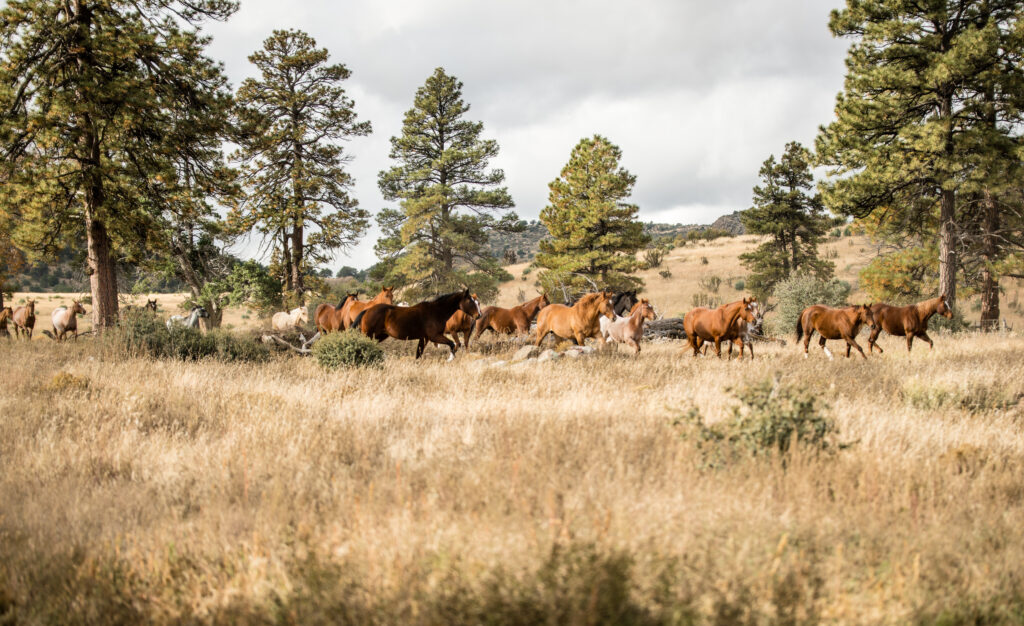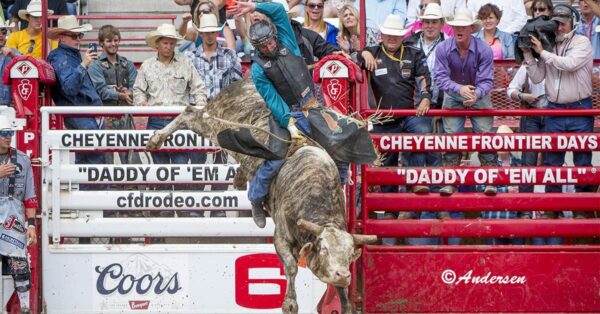While steeped in Arizona ranch history, the O RO is also a prime example of what innovation looks like in the horse industry.
Imagine wide open spaces with nothing but brush, grass, mountains, trees, and an occasional speck of black, white, or red dot the landscape surrounding you—no fence to be seen for miles. A quiet most in our modern era rarely experience. The wagon, an old one-ton Ford truck with a chuck box attached full of food and supplies, rolls out on rugged, bumpy roads at the beginning of the working season. The rest of the crew follows soon after to gather, work, and move cows across a landscape unmarred by human hands. The camp men welcome the seasonal help to get through the load but crave the solidarity offered when winter and summer roll in. And through all of this work, from start to finish, is the horse, a valued member of the RO team.

The O RO Ranch, owned by Jane and Larry Droppa and family, is steeped in Western tradition and heritage with a keen eye for modern innovations to raise the best beef possible. This ranch has used horses as their primary partners for over 125 years. A horse that is trainable but can think independently, one who is heavy-boned but can work all day, an animal who reads a cow while retaining its composure. Raising horses like this takes decades of thoughtful planning – they don’t just happen by accident. The actual O RO Ranch tells a long story, with the equine breeding program adding several chapters, if not volumes.
To truly understand what a horse needs to be, you need to understand the terrain and requirements of the ranch. The O RO Ranch is generally impassable by anything but a four-hooved vehicle, whether that be cows or horses. Stretches of dirt often passed off as roads allow minimal access to things like the wagon. A single fence or naturally occurring boundaries runs the circumference of the ranch with the work of caring for the cattle and the landscape across the vast 257,00 acres, a task taken on by five year-round cow camp men, headquarters, and seasonal cowpunchers. During the spring and fall, a remuda of horses is kept with the wagon as they move across the countryside to do their seasonal tasks. The days are long, and the terrain is some of the most rugged in the Southwest.

The O RO Ranch breeds, raises, and uses horses who carry lineage taking us back hundreds of years and deep into the heart of Mexico. The ranch has registered horses with the American Quarter Horse Association since the registry’s inception eighty-plus years ago. The selection of sires who carry the traits needed for this part of the world has been in practice almost from the beginning. This work has obviously paid off and is being recognized as the ROs were named the AQHA Best Remuda of 2022. Ranch Manager Jed Roark brought an eye for stock that not only works the ranch and does that well but can also head to the show and roping pen and compete at the top levels making these horses not just valuable on the range but elsewhere.
The life of a horse on the ranch starts with a band of thirty mares who were bred and selected for their ability to sustain their lives on what the land provides. Not only are they expected to fend for themselves but also to breed and foal without assistance. These mares are in bands with three studs, duplicating a horse’s natural environment. The foals are born in the rocks, so they know nothing else, making the transition to working life simple.

As yearlings, they experience a halter but then are let loose back on the mountains to continue growing. The saddle-breaking process makes the two-year-olds’ lives slightly more exciting, but after about fifteen rides, they are turned out to roam again. Much like a young person graduating from college, life gets more serious in their three-year-old year. They are again brought in off the mountain and asked to brush up on the skills they learned as two-year-olds. From there, they are assigned to the camp men, and some are picked to be wagon horses, meaning they are the horses used during the spring and fall working times.
In the spring, the job of the cowboys and their equine partners is branding calves, spreading bulls to ensure they are covering all cows, and weaning off any older calves who may have missed the wagon in the fall. Each morning, cowboys saddle up and head out to gather what cows they can find in the rideable area, do the work needed, and then set out to do it all the next day. Only Sundays see rest, mainly in the form of a hot shower and maybe some laundry at the ranch headquarters. It starts all over again on Monday.

As the work is completed in one area, the camp gets packed up and moved to the next area of the ranch. This is repeated for a solid two to three months. A brief intermission called summer brings some respite, but as the days start to cool towards the end of that season, the fall works come into view. The harvest months bring weaning of the calves from the mother cows, sifting through the herd to cull or get rid of older cows, and taking the bulls off the herd. All of this work, spring and fall, and the months in between, is only suited for individuals, both human and horse, who are physically and mentally strong. This kind of work wears a body out, but in a way that leaves one satisfied at the end of the day or the end of life.
A slow start, with a chance to live life as nature intended, makes for a solid horse physically, but also has incredible benefits for the horses mentally. All horses are rotated into the working string for a season and then turned out for a season, giving a chance for much-needed rest and recovery. This horse management method also ensures the animal’s longevity, which is a challenging task in the terrain of the ROs.

A recent win at the BFI Roping by an RO horse clearly shows the results of this program. RO Master Memphis, a horse bred, raised, and used on the O RO Ranch, currently owned by Jeff Tebow and ridden by Curry Kirchner, won one of the biggest ropings of the year at the beginning of April. Twister, as he is commonly known, started his career as a camp horse doing everyday tasks on the ranch. After his ranch working days, he was sold to the Hershberger family, who used him for roping, ranching, and picking up broncs until he was sold to his current owner. Because of the quality care given to these horses, most are sold to the public after ranch life is done and go on to make incredible partners for their new owners. Each horse is individually considered throughout their lifetime at the ranch, ensuring they are placed where it can thrive.
The American Quarter horse has long been known for its functionality, versatility, and adaptability. The AQHA Best Remuda Award recognizes the ranch-type quarter horses integral to the West’s expansion and the registry’s foundation. In places like the rugged landscape of northwestern Arizona, the qualities of the horses who built the base of the American Quarter Horse are still a requirement, not just history. The O RO Ranch gives one a feeling of stepping back in time after a glance, but upon closer inspection, one sees innovation and continuous improvement. We improve only by learning from our past and applying those lessons to the future. This lesson is fully recognized and implemented with the cattle herd on this rough terrain and in a horse program that makes exceptional horses for the job required.

Cowboy Lifestyle Magazine
This article on the O RO Ranch was created for the Summer Issue of the Cowboy Lifestyle Magazine which was released in June 2023. You can catch this article and many more by checking out the full issue. For more information on Cowboy Lifestyle Magazine, visit the website here.
Last Updated on 09/08/2023 by Tiffany Selchow
CLN Community Sponsor












